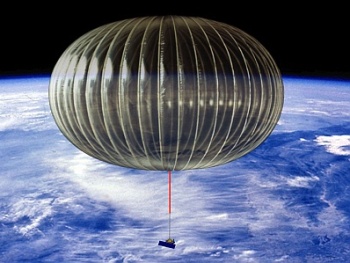Purpose of the flight and payload description
A project to develope a balloon system capable of providing scientific measurements for 100-day missions with floating altitude close to 35km transporting payloads of near 1.5 tons.
It is a super-pressure balloon made of a composite fabric (polyester + polyethylene film and fabric) that is filled with Helium and hermetically sealed. Meridional tendons provide additional rigidity to the envelope. The pressure inside the envelop is maintained above the ambient pressure at all times to keep the balloon afloat at a constant altitude. During daytime the internal pressure increases due to solar heating but the volume remains constant due to the rigidity of the envelope. At night the pressure drops due to infrared radiative cooling to space, but as long as the internal pressure remains above the ambient pressure, the balloon stays at the same altitude.
On the future, transported by stratospheric winds around the globe at 30m/s the ULDB would be make a full circunnavegation to Earth in about 2 weeks.
Details of the balloon flight
Balloon launched on: 8/19/2008
Launch site: Scientific Flight Balloon Facility, Fort Sumner, (NM), US
Balloon launched by: Columbia Scientific Balloon Facility (CSBF)
Balloon manufacturer/size/composition: Ultra Long Duration Balloon Aerostar - 7.000.000 ft3
End of flight (L for landing time, W for last contact, otherwise termination time): 8/19/2008
Landing site: Ground Abort - No Flight
Ground Abort - No Flight
The success of the previous mission (586NT) flown on June 22, 2008 from Ft. Sumner, New Mexico paved the way for the desired next step of increasing the total suspended load and an increase the target float altitude, so this flight was intended to be performed steping up the size up to 7,000,000 ft3.
The balloon was built and prepared to be launched again from Fort Sumner in the Fall of 2008, but there was an issue with the inflation process of that balloon and the launch was scrubbed.
The post failure investigation of the engineers was centered around the inflation tubes. From a video taken at the launch pad appeared that the inflation tube came off during inflation, thus one tube was introducing helium in the balloon and the other had helium venting to the atmosphere.
After that, the program made a decision to try the first launch attempt of this scaled up balloon from Antarctica in late 2008.
External references
- ULDB website - Balloon Programe Office NASA Wallops flight facility
3598If you consider this website interesting or useful, you can help me to keep it up and running with a small donation to cover the operational costs. Just the equivalent of the price of a cup of coffee helps a lot.


